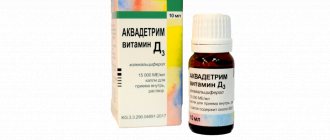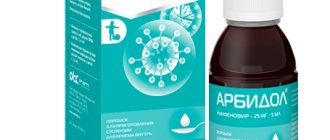Antigrippin powder for the preparation of solution for internal use, chamomile N 10
Active substance
paracetamol (paracetamol)
ATX code
N02BE51 (Paracetamol in combination with other drugs (excluding psycholeptics))
Dosage forms
powder for solution for oral administration
Release form, packaging and composition of the drug
◊ Powder for preparing a solution for oral administration, honey-lemon
varying degrees of granulation, consisting of particles from white to grayish-beige in color, with a specific odor; inclusions of dark brown color are allowed.
| 1 pack | |
| paracetamol | 500 mg |
| chlorphenamine maleate | 10 mg |
| ascorbic acid | 200 mg |
[PRING] sodium bicarbonate - 644 mg, citric acid - 1328 mg; sorbitol - 317 mg; povidone - 16 mg; sucrose - 1793 mg; sodium cyclamate - 42 mg; aspartame - 20 mg; acesulfame potassium - 15 mg; lemon flavoring - 55 mg, caramel coloring - 15 mg, honey flavoring - 45 mg.
5 g - bags (3) - cardboard packs. 5 g - sachets (10) - cardboard packs.
◊ Chamomile powder for oral solution
varying degrees of granulation, consisting of particles from white to beige and light brown, with a specific odor; inclusions of brown color are allowed.
| 1 pack | |
| paracetamol | 500 mg |
| chlorphenamine maleate | 10 mg |
| ascorbic acid | 200 mg |
[PRING] sodium bicarbonate - 644 mg, citric acid - 928 mg; sorbitol - 317 mg; povidone - 16 mg; sucrose - 2058 mg; sodium cyclamate - 42 mg; aspartame - 20 mg; acesulfame potassium - 15 mg; chamomile extract - 250 mg.
5 g - sachets (10) - cardboard packs.
Clinical and pharmacological group
Drug for symptomatic treatment of acute respiratory diseases
Pharmacotherapeutic group
A remedy for eliminating the symptoms of acute respiratory infections and “colds” (non-narcotic analgesic + H1-histamine receptor blocker + vitamin)
Indications for use
- infectious and inflammatory diseases (ARVI, influenza), accompanied by fever, chills, headache, joint and muscle pain, nasal congestion and pain in the throat and sinuses.
Dosage
The drug is taken orally. The contents of the sachet should be completely dissolved in a glass (200 ml) of warm water (50-60°C) and the resulting solution should be drunk immediately. It is better to take the drug between meals.
Adults and children over 15 years old
- 1 sachet 2-3 times/day. The interval between doses of the drug should be at least 4 hours. The maximum daily dose is 3 sachets.
In patients with impaired liver or kidney function
and
elderly patients,
the interval between doses of the drug should be at least 8 hours.
The duration of use of the drug without consulting a doctor is no more than 5 days when prescribed as an analgesic and 3 days as an antipyretic.
Contraindications
- erosive and ulcerative lesions of the gastrointestinal tract (in the acute phase);
- severe renal and/or liver failure;
- alcoholism;
- angle-closure glaucoma;
- phenylketonuria;
- prostatic hyperplasia;
- children under 15 years of age;
- pregnancy;
- lactation period;
- hypersensitivity to paracetamol, ascorbic acid, chlorphenamine or any other component of the drug.
Carefully:
renal and/or liver failure, glucose-6-phosphate dehydrogenase deficiency, congenital hyperbilirubinemia (Gilbert, Dubin-Johnson and Rotor syndromes), viral hepatitis, alcoholic hepatitis, old age.
Overdose
Symptoms of a drug overdose are caused by the substances included in its composition. The clinical picture of acute intoxication with paracetamol develops within 6-14 hours after taking it. Symptoms of chronic intoxication appear 2-4 days after an overdose.
Symptoms of acute paracetamol intoxication:
diarrhea, loss of appetite, nausea and vomiting, abdominal discomfort and/or abdominal pain, increased sweating.
Symptoms of chlorphenamine intoxication:
dizziness, agitation, sleep disturbances, depression, convulsions.
Treatment:
symptomatic.
Side effects
The drug is well tolerated in recommended doses.
From the nervous system:
in isolated cases - headache, feeling of fatigue.
From the digestive system:
in isolated cases - nausea, pain in the epigastric region.
From the endocrine system:
in isolated cases - hypoglycemia (up to the development of coma).
From the hematopoietic system:
in isolated cases - anemia, hemolytic anemia (especially for patients with glucose-6-phosphate dehydrogenase deficiency); extremely rarely - thrombocytopenia.
Allergic reactions:
in isolated cases - skin rash, itching, urticaria, Quincke's edema, anaphylactoid reactions (including anaphylactic shock), exudative erythema multiforme (including Stevens-Johnson syndrome), toxic epidermal necrolysis (Lyell's syndrome).
Other:
in isolated cases - hypervitaminosis C, metabolic disorders, feeling of heat, dry mouth, accommodation paresis, urinary retention, drowsiness.
The patient should report all side effects of the drug to the doctor.
Overdose
Ascorbic acid
Increases the concentration of benzylpenicillin and tetracyclines in the blood.
Improves the absorption of iron preparations in the intestines (converts ferric iron to divalent iron); may increase iron excretion when used concomitantly with deferoxamine.
Increases the risk of developing crystalluria during treatment with salicylates and short-acting sulfonamides, slows down the excretion of acids by the kidneys, increases the excretion of drugs that have an alkaline reaction (including alkaloids), and reduces the concentration of oral contraceptives in the blood.
Increases overall ethanol clearance.
When used simultaneously, it reduces the chronotropic effect of isoprenaline.
It can either increase or decrease the effect of anticoagulant drugs.
Reduces the therapeutic effect of antipsychotic drugs (neuroleptics) - phenothiazine derivatives, tubular reabsorption of amphetamine and tricyclic antidepressants.
Concomitant use of barbiturates increases the excretion of ascorbic acid in the urine.
Chlorphenamine maleate
Chlorphenamine maleate enhances the effect of hypnotics.
Antidepressants, antiparkinsonian drugs, antipsychotic drugs (phenothiazine derivatives) increase the risk of side effects (urinary retention, dry mouth, constipation).
Glucocorticoids increase the risk of developing glaucoma.
Ethanol enhances the sedative effect of chlorphenamine maleate.
Paracetamol
When paracetamol interacts with inducers of microsomal oxidation in the liver (phenytoin, ethanol, barbiturates, rifampicin, phenylbutazone, tricyclic antidepressants), the production of hydroxylated active metabolites increases, which makes it possible to develop severe intoxications with small overdoses.
While taking paracetamol, ethanol contributes to the development of acute pancreatitis.
Inhibitors of microsomal oxidation (including cimetidine) reduce the risk of hepatotoxicity.
The simultaneous use of diflunisal and paracetamol increases the plasma concentration of the latter by 50%, increasing hepatotoxicity.
Concomitant use of barbiturates reduces the effectiveness of paracetamol.
Paracetamol reduces the effectiveness of uricosuric drugs.
Storage conditions
The drug should be stored out of the reach of children at a temperature of 10-30°C. Shelf life: 3 years. Do not use after the expiration date.
Conditions for dispensing from pharmacies
The drug is available without a prescription.
RUS-FLU-ANG-GPR-07-2018-1218
Special Instructions
If you are taking metoclopramide, domperidone or cholestyramine, you should also consult your doctor.
With long-term use in doses significantly higher than recommended, the likelihood of impaired liver and kidney function increases; monitoring of the peripheral blood picture is necessary.
Paracetamol and ascorbic acid can distort laboratory tests (quantitative determination of glucose and uric acid in blood plasma, bilirubin, liver transaminase activity, LDH).
To avoid toxic liver damage, paracetamol should not be combined with alcoholic beverages, or taken by persons prone to chronic alcohol consumption. The risk of developing liver damage increases in patients with alcoholic hepatosis.
Prescribing ascorbic acid to patients with rapidly proliferating and intensively metastasizing tumors can aggravate the process.
In patients with high iron levels in the body, ascorbic acid should be used in minimal doses.
1 sachet of honey-lemon powder contains 1.793 g of sugar, which corresponds to 0.15 XE.
1 sachet of chamomile powder contains 2.058 g of sugar, which corresponds to 0.17 XE.
Antigrippin-Express
Ethanol enhances the sedative effect and promotes the development of acute pancreatitis.
Antidepressants, antiparkinsonian drugs, antipsychotic drugs (phenothiazine derivatives) increase the risk of side effects (urinary retention, dry mouth, constipation).
Glucocorticosteroids increase the risk of developing glaucoma; with long-term use, they deplete ascorbic acid reserves.
Inducers of microsomal liver enzymes (barbiturates, phenytoin, phenylbutazone, rifampicin, zidovudine, carbamazepine, tricyclic antidepressants), ethanol and hepatotoxic drugs increase the production of hydroxylated active metabolites, increasing the risk of developing severe intoxications with small overdoses.
Barbiturates and primidone increase the excretion of ascorbic acid in the urine.
Inhibitors of microsomal oxidation (including cimetidine) reduce the risk of hepatotoxicity.
With long-term combined use with other non-steroidal anti-inflammatory drugs, the risk of developing “analgesic” nephropathy and renal papillary necrosis, and the onset of end-stage renal failure increases.
Diflunisal increases plasma concentrations of paracetamol by 50%, increasing hepatotoxicity.
Long-term use in high doses concomitantly with salicylates increases the risk of developing kidney or bladder cancer.
When used simultaneously with acetylsalicylic acid (ASA), the absorption of ascorbic acid decreases (by about 30%) and its excretion in urine increases, and the excretion of ASA decreases.
Myelotoxic drugs increase the manifestations of hematotoxicity of the drug.
Drugs of the quinoline series, calcium chloride, when used for a long time, deplete reserves of ascorbic acid; oral contraceptives, fresh juices and alkaline drinks reduce its absorption and assimilation.
Paracetamol, which is part of the drug, reduces the effectiveness of uricosuric drugs; when taken in high doses, it increases the effect of anticoagulant drugs.
Ascorbic acid increases the concentration of benzylpenicillin and tetracyclines in the blood, and at a dose of 5 sachets per day increases the bioavailability of ethinyl estradiol; improves the absorption of iron preparations in the intestine, can increase the excretion of iron when used simultaneously with deferoxamine; reduces the effectiveness of heparin and indirect anticoagulants; increases the risk of developing crystalluria during treatment with salicylates and short-acting sulfonamides, slows down the excretion of acids by the kidneys and increases the excretion of drugs that have an alkaline reaction (including alkaloids); reduces the blood concentration of oral contraceptives; increases the overall clearance of ethanol, which in turn reduces the concentration of ascorbic acid in the body; reduces the therapeutic effect of antipsychotic drugs - phenothiazine derivatives, tubular reabsorption of amphetamine and tricyclic antidepressants; when used simultaneously, it reduces the chronotropic effect of isoprenaline; with long-term use or use in high doses, it may interfere with the interaction of disulfiram and ethanol; in high doses increases the excretion of mexiletine by the kidneys.


